
- SAP Community
- Groups
- Interest Groups
- Application Development
- Blog Posts
- Custom input helps
Application Development Blog Posts
Learn and share on deeper, cross technology development topics such as integration and connectivity, automation, cloud extensibility, developing at scale, and security.
Turn on suggestions
Auto-suggest helps you quickly narrow down your search results by suggesting possible matches as you type.
Showing results for
LaurensDeprost
Contributor
Options
- Subscribe to RSS Feed
- Mark as New
- Mark as Read
- Bookmark
- Subscribe
- Printer Friendly Page
- Report Inappropriate Content
08-04-2021
3:58 PM
What to do when there is no user friendly standard value help available for a given data element? Find out how to enable end-users to easily make a selection with a custom implementation. This post uses calendar week as an example for value helps and FOR expressions.

- The example
- The approach
- Implementing a custom search help
- Generating a value list at runtime
- Further reading
- Conclusion
The example
Data element
KWEEK refers to a factory calendar week in the format YYYYMM. Sadly, there is no standard search help available.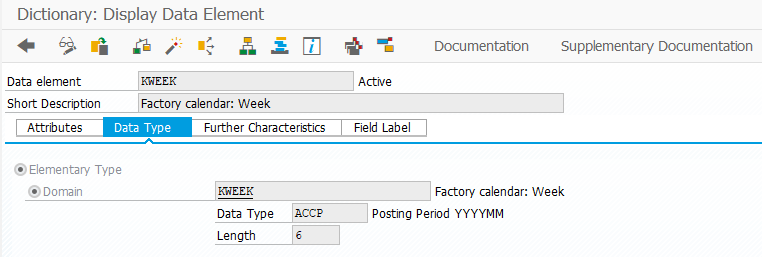
KWEEK in the ABAP DictionaryThere are alternatives in search helps RSCALWEEK and /BI0/OCALWEEK.
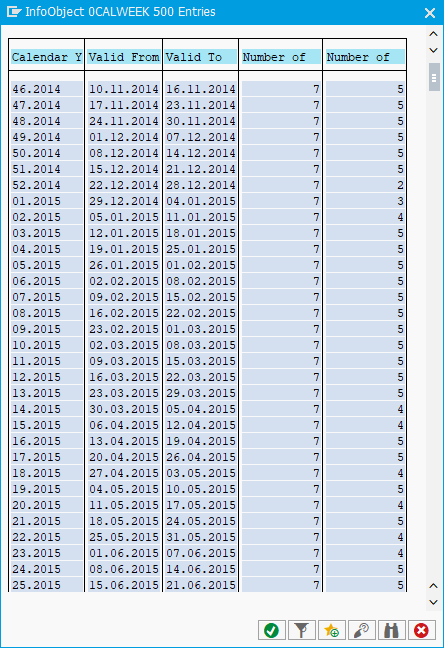
/BI0/OCALWEEK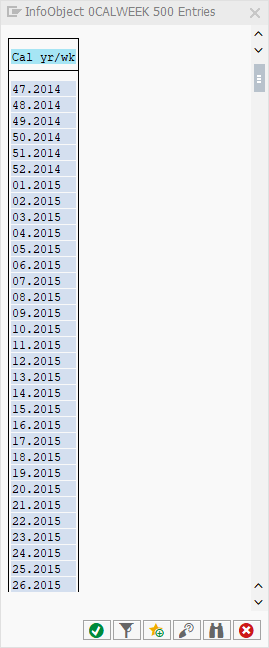
RSCALWEEKHowever, these are not user-friendly, partly because the input starts way in the past. So let’s help our end-users easily select a week with a custom implementation.
The approach
Data type: value list columns
To provide end-users with a list of possibilities, we first need to determine the relevant fields to display and their respective data types. In our example, we opt for the year, week number, and calendar week (the concatenation of the two aforementioned fields).
"data type for value help entries
TYPES:
BEGIN OF week_calendar_value_help,
year TYPE ajahr,
week TYPE weekn,
calendar_week TYPE kweek,
END OF week_calendar_value_help,
t_week_calendar_value_help TYPE STANDARD TABLE OF week_calendar_value_help
WITH DEFAULT KEY.
Preparing the values
Let’s assume the end-user should be able to select a calendar week for the current year, up to two years in the past, and up to two years in the future. This requirement is an ideal use-case for the
FOR expression, which we can use in a nested way to fill all week values (52 for the number of weeks in a year)* for every relevant year.*Note: this is a simplified representation since some years have 53 weeks.
CONSTANTS weeks_in_a_year TYPE i VALUE 52.
CONSTANTS value_help_years_in_past TYPE i VALUE 2.
CONSTANTS value_help_years_in_future TYPE i VALUE 2.
"prepare value help table containing calendar week numbers
"going x amount of years in the past and future
DATA(calendar_weeks) = VALUE t_week_calendar_value_help(
LET current_year = sy-datum(4) IN
FOR year = CONV int2( current_year - value_help_years_in_past )
UNTIL year > current_year + value_help_years_in_future
FOR weeknumber = 1 UNTIL weeknumber > weeks_in_a_year
LET week = |{ CONV char2( weeknumber ) ALPHA = IN }|
IN ( year = year
week = weeknumber
calendar_week = |{ year }{ week }| ) ).Let’s deconstruct the code snippet above.
To start, we construct our value help table using the VALUE operator. Inside, we define a helper variable for the current year using a LET expression.
Afterwards we start a first conditional iteration using the FOR operator: we specify we want to iterate from two years in the past (
year = CONV int2( current_year - value_help_years_in_past) until two years in the future (UNTIL year > current_year + value_help_years_in_future).Inside this main iteration, we iterate a second time over the week numbers in a year (52), once again using the FOR operator. In this inner iteration, we fill our table value.
Implementing a custom search help
Creating the search help
To create a custom search help:
- Open either the ABAP Development Tools in Eclipse or transactions SE80 (Repository Browser) or SE11 (ABAP Dictionary) in the SAP GUI.
- Follow the steps as described in Creating Elementary Search Helps on the SAP Help Portal.
- Define the parameters calendar week (
KWEEK), year (AJAHR), and week (WEEKN) as shown in the screenshot below. - Save the new search help.
Create and activate the search help exit (see below). - Finally, assign the exit and activate the search help.
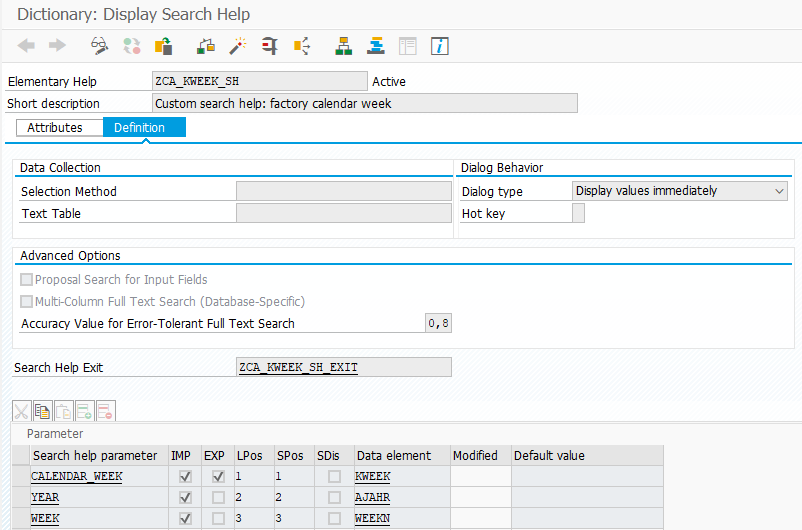
Creating the search help exit
To get started quickly, copy the demo function module
F4IF_SHLP_EXIT_EXAMPLE. There is no need to change the interface.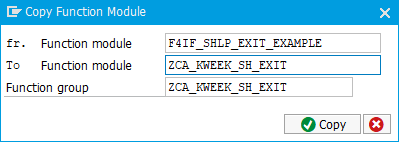
As described above, the code in our search help exit below uses a nested FOR expression to provide a week calendar value list to the end user. Here the user can choose any week up to two years in the past or future.
Check out the example search help exit.
Note that this is a simplified representation since some years have 53 weeks.
See the demo program below for the full code that takes this into account.
FUNCTION zca_kweek_sh_exit.
*"----------------------------------------------------------------------
*"*"Local Interface:
*" TABLES
*" SHLP_TAB TYPE SHLP_DESCR_TAB_T
*" RECORD_TAB STRUCTURE SEAHLPRES
*" CHANGING
*" VALUE(SHLP) TYPE SHLP_DESCR_T
*" VALUE(CALLCONTROL) LIKE DDSHF4CTRL STRUCTURE DDSHF4CTRL
*"----------------------------------------------------------------------
IF callcontrol-step = 'DISP'.
TYPES:
BEGIN OF week_calendar_value_help,
year TYPE ajahr,
week TYPE weekn,
calendar_week TYPE kweek,
END OF week_calendar_value_help,
t_week_calendar_value_help TYPE STANDARD TABLE OF
week_calendar_value_help WITH DEFAULT KEY.
"handle 'F4'/value help request for the week calendar parameter
CONSTANTS weeks_in_a_year TYPE i VALUE 52.
CONSTANTS value_help_years_in_past TYPE i VALUE 2.
CONSTANTS value_help_years_in_future TYPE i VALUE 2.
"prepare value help table containing calendar week numbers
"going x amount of years in the past and future
DATA(calendar_weeks) = VALUE t_week_calendar_value_help(
LET current_year = sy-datum(4) IN
FOR year = CONV int2( current_year - value_help_years_in_past )
UNTIL year > current_year + value_help_years_in_future
FOR weeknumber = 1 UNTIL weeknumber > weeks_in_a_year
LET week = |{ CONV char2( weeknumber ) ALPHA = IN }|
IN ( year = year
week = weeknumber
calendar_week = |{ year }{ week }| ) ).
LOOP AT calendar_weeks ASSIGNING FIELD-SYMBOL(<calender_week>).
LOOP AT shlp_tab[ 1 ]-fielddescr ASSIGNING FIELD-SYMBOL(<fielddescr>).
ASSIGN COMPONENT <fielddescr>-fieldname
OF STRUCTURE <calender_week> TO FIELD-SYMBOL(<value>).
CALL FUNCTION 'F4UT_PARAMETER_RESULTS_PUT'
EXPORTING
parameter = <fielddescr>-fieldname
value = <value>
fieldname = CONV dfies-lfieldname( <fielddescr>-fieldname )
TABLES
shlp_tab = shlp_tab
record_tab = record_tab
source_tab = calendar_weeks
CHANGING
shlp = shlp
callcontrol = callcontrol
EXCEPTIONS
parameter_unknown = 1
OTHERS = 2.
ENDLOOP.
ENDLOOP.
ENDIF.
ENDFUNCTION.Generating a value list at runtime
A second option is to handle a value request for a selection screen without creating a custom search help but generating a value list at runtime.
The benefits of using search helps
Note that before using this approach, one should reconsider whether a custom search help would not be the better option. Search helps can be attached to a data element or a field of a structure. The F4 help is then automatically available for all users of the data element or structure.
Implementation
Self-programmed value lists are achieved via function module
F4IF_INT_TABLE_VALUE_REQUEST.The SAP Help Portal clearly describes how the function can be used.
This function module displays a value list that you created in an ABAP program. The self-programmed value list is passed to the function module as the table parameter VALUE_TAB. If you specify the import parameters DYNPPROG, DYNPNR, and DYNPROFIELD, the user's selection is returned to the corresponding field on the screen. If you specify the table parameter RETURN_TAB, the selection is returned into the table instead.
Demo program
The demo program below uses the function module described above in conjunction with a nested FOR expression (see ‘Preparing the values’) to provide a value list to the end-user. Here the user can choose any week up to two years in the past or future.
In addition, this implementation takes into account the fact that some years contain 53 weeks instead of 52. The number of weeks in a year is determined using a helper method that calls FM 'DATE_GET_WEEK'. The year 2026 is used as an example.

A value list generated at runtime
Check out the demo program.
*&---------------------------------------------------------------------*
*& Report ZKWEEKDEMO
*&---------------------------------------------------------------------*
*& Demo program for custom value help for factory calendar week (KWEEK)
*&
*&---------------------------------------------------------------------*
REPORT zkweekdemo.
"data type for value help entries
TYPES:
BEGIN OF week_calendar_value_help,
year TYPE ajahr,
week TYPE weekn,
calendar_week TYPE kweek,
END OF week_calendar_value_help,
t_week_calendar_value_help TYPE STANDARD TABLE OF
week_calendar_value_help WITH DEFAULT KEY.
"Helper class for determining the number of weeks in a given year
CLASS lcl_week_number_helper DEFINITION.
PUBLIC SECTION.
CLASS-METHODS get_weeks_in_year
IMPORTING
iv_year TYPE ajahr
RETURNING
VALUE(rv_amount_of_weeks) TYPE i.
ENDCLASS.
CLASS lcl_week_number_helper IMPLEMENTATION.
METHOD get_weeks_in_year.
DATA lv_max_calendar_week TYPE kweek.
DATA(lv_last_day_of_year) = CONV dats( |{ iv_year }1231| ).
WHILE lv_max_calendar_week(4) NE iv_year AND sy-subrc = 0.
CALL FUNCTION 'DATE_GET_WEEK'
EXPORTING
date = lv_last_day_of_year
IMPORTING
week = lv_max_calendar_week.
"try again with an earlier date
"if the week returned is in the wrong/next year
lv_last_day_of_year -= 1.
ENDWHILE.
rv_amount_of_weeks = CONV #( lv_max_calendar_week+4 ).
ENDMETHOD.
ENDCLASS.
PARAMETERS pa_kweek TYPE kweek.
"handle 'F4'/value help request for the week calendar parameter
AT SELECTION-SCREEN ON VALUE-REQUEST FOR pa_kweek.
"2026 is an example of a year with 53 ISO calendar weeks
CONSTANTS start_year TYPE i VALUE 2026.
CONSTANTS value_help_years_in_past TYPE i VALUE 2.
CONSTANTS value_help_years_in_future TYPE i VALUE 2.
"prepare value help table containing calendar week numbers
"going x amount of years in the past and future
DATA(calendar_weeks) = VALUE t_week_calendar_value_help(
FOR current_year = start_year - value_help_years_in_past
UNTIL current_year > start_year + value_help_years_in_future
"determine number of weeks in each year
"since some years have 53 weeks
FOR weeknumber = 1
UNTIL weeknumber > lcl_week_number_helper=>get_weeks_in_year( CONV #( current_year ) )
LET week = |{ CONV char2( weeknumber ) ALPHA = IN }|
IN ( year = current_year
week = weeknumber
calendar_week = |{ current_year }{ week }| ) ).
CALL FUNCTION 'F4IF_INT_TABLE_VALUE_REQUEST'
EXPORTING
retfield = 'CALENDAR_WEEK'
dynpprog = sy-repid
dynpnr = sy-dynnr
dynprofield = 'PA_KWEEK'
value_org = 'S'
TABLES
value_tab = calendar_weeks
EXCEPTIONS
parameter_error = 1
no_values_found = 2
OTHERS = 3.Further reading
- Input Help in Dialog Modules, SAP Help Portal
- Creating Elementary Search Helps, SAP Help Portal
- FOR - Conditional Iteration, ABAP Keyword Documentation
- F4 Week Calendar, SAP Community Q&A
Conclusion
This post shows how to offer value lists when standard SAP does not suffice through a concrete example. Next to generating a list of values at runtime and creating a custom search help with the corresponding search help exit, we saw an interesting application of the ‘FOR’ expression.
- SAP Managed Tags:
- ABAP Development
2 Comments
You must be a registered user to add a comment. If you've already registered, sign in. Otherwise, register and sign in.
Labels in this area
-
A Dynamic Memory Allocation Tool
1 -
ABAP
8 -
abap cds
1 -
ABAP CDS Views
14 -
ABAP class
1 -
ABAP Cloud
1 -
ABAP Development
4 -
ABAP in Eclipse
1 -
ABAP Keyword Documentation
2 -
ABAP OOABAP
2 -
ABAP Programming
1 -
abap technical
1 -
ABAP test cockpit
7 -
ABAP test cokpit
1 -
ADT
1 -
Advanced Event Mesh
1 -
AEM
1 -
AI
1 -
API and Integration
1 -
APIs
8 -
APIs ABAP
1 -
App Dev and Integration
1 -
Application Development
2 -
application job
1 -
archivelinks
1 -
Automation
2 -
BTP
1 -
CAP
1 -
CAPM
1 -
Career Development
3 -
CL_GUI_FRONTEND_SERVICES
1 -
CL_SALV_TABLE
1 -
Cloud Extensibility
8 -
Cloud Native
6 -
Cloud Platform Integration
1 -
CloudEvents
2 -
CMIS
1 -
Connection
1 -
container
1 -
Debugging
2 -
Developer extensibility
1 -
Developing at Scale
4 -
DMS
1 -
dynamic logpoints
1 -
Eclipse ADT ABAP Development Tools
1 -
EDA
1 -
Event Mesh
1 -
Expert
1 -
Field Symbols in ABAP
1 -
Fiori
1 -
Fiori App Extension
1 -
Forms & Templates
1 -
IBM watsonx
1 -
Integration & Connectivity
9 -
JavaScripts used by Adobe Forms
1 -
joule
1 -
NodeJS
1 -
ODATA
3 -
OOABAP
3 -
Outbound queue
1 -
Product Updates
1 -
Programming Models
12 -
RFC
1 -
RFFOEDI1
1 -
SAP BAS
1 -
SAP BTP
1 -
SAP Build
1 -
SAP Build apps
1 -
SAP Build CodeJam
1 -
SAP CodeTalk
1 -
SAP Odata
1 -
SAP UI5
1 -
SAP UI5 Custom Library
1 -
SAPEnhancements
1 -
SapMachine
1 -
security
3 -
text editor
1 -
Tools
14 -
User Experience
4
Top kudoed authors
| User | Count |
|---|---|
| 6 | |
| 2 | |
| 2 | |
| 2 | |
| 2 | |
| 2 | |
| 1 | |
| 1 |